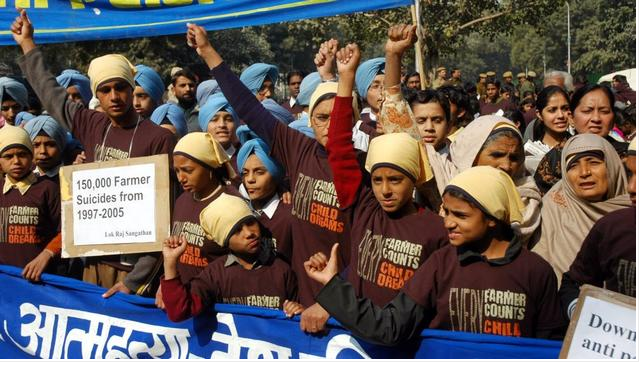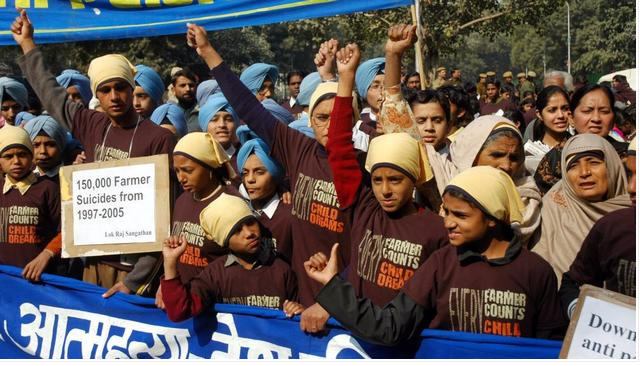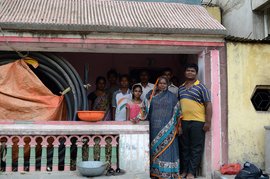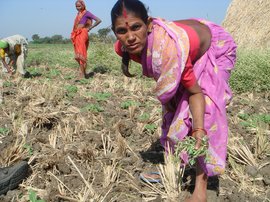Kafka might have envied the script. In Delhi, Union Agriculture Minister Sharad Pawar informed the Rajya Sabha on May 7 that there had been just six farmers' suicides in Vidarbha since January. The same day, same time in Maharashtra, Chief Minister Ashok Chavan said that figure was 343. That is, 57 times greater than Mr. Pawar's count. Mr. Chavan was speaking in Vidarbha. Mr. Pawar's numbers came in a written reply to a question in Parliament. Both stories were reported by the Press Trust of India (PTI). All in a day's work.
Confused? Try this: Five days earlier, Minister of State for Agriculture K.V. Thomas pitched his count at 23 suicides in Vidarbha since January. In the same week — in the same Rajya Sabha. And Mr. Thomas said his source was “the government of Maharashtra.” Whose chief minister says the number is 343. Meanwhile, before Mr. Pawar gave the figure of 'only six' in four months, the government's Vasantrao Naik Farmers' Self Reliance Mission in Vidarbha put the number at 62 for just January alone.
Can estimates of farm suicides — all of them official — vary by over 5,500 per cent? (Mr. Chavan's is that much higher than Mr. Pawar's). But it doesn't end there. Maharashtra Revenue Minister Narayan Rane informed the State Assembly in April that there have been 5,574 suicides in Vidarbha since 2006. But Parliament is told only six have occurred since January this year. Mr. Rane's count for the whole state since 2006 is 7,786 farm suicides. That is more than double Mr. Pawar's new count of 3,450 for the whole country in the last three years .

In this Jan 31, 2008 picture, members of Lok Raj Sangathan, led by family members of farmers of Punjab who had committed suicide, stage a protest in New Delhi against the anti-farmer policies of Central and Punjab Government
That's odd — 3,450 for the whole country? In three years? The National Crime Records Bureau puts the number in the last three years at nearly 50,000. That is for 2006, 2007 and 2008 (the last year for which data are available). And the NCRB is the only source for farm suicide data at the national level. Its data also show us that nearly 200,000 farmers have killed themselves between 1997 and 2008. So whose numbers are being fed to Parliament? And how come we have so many wildly varying counts? That too when there is only one body with authentic data. And why does this happen mostly with Maharashtra?
Because Maharashtra's numbers are the worst in the country. This state has seen 41,404 farmers' suicides since 1997. Of these, 12,493 have occurred in 2006-08. So the pressure to cover up is greater here than anywhere else.
The concern was never about the farmer. Till the Prime Minister's 2006 Vidarbha visit, the state's top ministers had never been to a distress-hit village on this issue. Most have still not visited a single suicide-hit farm household. They cared little for what people thought of them. But they did fear the displeasure of their own high command in New Delhi — by then alarmed at the rising suicide numbers. So they began massaging the figures.
First, this meant attaching an impossible number of indicators to identify a farm suicide. As early as June 2005, people in Malwagad, Yavatmal were mocking the process when we arrived there after the suicide of Digambar Agose. “Now we can't even commit suicide in peace,” laughed one of Agose's neighbours with graveyard humour. “Not without reading those forms the officials have created to see we get it right.” Another pointed out: “There are some 40 clauses on their inquiry list. All these must apply.” In short, if you must kill yourself, get it right. Make sure you adhere to the pro forma . Then your family is ‘eligible' for compensation.
Hundreds of people were dropped from the farm suicide lists on the ground that they were not farmers. “There's no land in their names,” officials asserted. On the ground, this meant most women farmers taking their lives were excluded. As also, many eldest sons who actually ran the farm while the land remained in their aged fathers' names. The lists also shut out many dalit and adivasi peasants — whose title to land is seldom clear.
And yet the numbers kept mounting. The reporting of the issue was hurting where it mattered: in Delhi. So how to bring down the count? Ambitious bureaucrats stepped forward to create new categories. 'Eligible' and 'ineligible' suicides. Only the former would be counted as “farm suicides.” An official document set this trend in 2006.
It created a table with many new columns. With each of these, the numbers fell. How? After the total or farm suicides, came a new group: “Family members' suicides.” This means family members on the farm killing themselves are not counted as farmers. That helped skim down the figure still more. Next, an “Investigated Cases” column that saw numbers plummet further. The final column was truly novel — “Eligible Suicides.” That is, those the government deems worthy of compensation. And so, for 2005, the suicides column that begins at 2,425 ends with 273. (Less than 12 per cent of the total). This amputated figure becomes the official farm suicides count. And a ‘decline' is established.
And so the coming of ‘non-genuine suicides.' This did not mean the man was any less dead. Or that he had not killed himself. It meant the government could not accept his death had been driven by debt and distress. (Even though quite a few suicide notes cited precisely those reasons.) Committees were set up in the crisis districts to check if the suicides were ‘genuine.' These bodies soon ran berserk, often declaring every single suicide in a month to be ‘non-genuine.' Their hatchet job means that very few families suffering a breadwinner's suicide get any compensation from government.
And that's how it's still done. Mr. Rane's reply to a question in the state assembly lists thousands of ‘ineligible suicides' over four years.
The problem of the NCRB's data however, remains. These are not in their hands to fudge. Sure, over time, even the NCRB's data will be corrupted by the fiddles at the ground level. But it is the here and now of politics that matters. The only way to get around this is to simply ignore the NCRB. So the Minister's written reply in Parliament makes no mention of it. You can see the change from the past.
NCRB data was precisely what he cited in 2007 when confirming there had been nearly 1.5 lakh farm suicides between 1997 and 2005. Replying to Starred Question No. 238 in the Rajya Sabha (Nov. 30, 2007), Mr. Pawar's numbers tallied to the last digit with those reported in The Hindu (Nov.12-17) two weeks earlier. The Hindu 's reports were based on the comprehensive study of official data on farm suicides by Professor K. Nagaraj, then with the Madras Institute of Development Studies. The data analysed by him were from the NCRB. It publishes these in its Accidental Deaths and Suicides in India (ADSI) report each year. A part of the Union Ministry of Home Affairs, the NCRB is the only body that exists, which tracks suicides of all categories across the country.
Following Dr. Nagaraj's study, The Hindu updated the farm suicide figures each year, drawing from the latest NCRB reports. (All these reports are available on their website. For instance, the 2008 data in the category of “Self Employed (Farming / Agriculture)” counts farmers' suicides for that year as 16,196 . (Check it yourselves on http://ncrb.gov.in/StatPublications/ADSI/ADSI2013/ADSI-2013.pdf ). But in Mr. Pawar's Rajya Sabha reply this May, that figure is 1,237 (no source cited. At least not in the PTI report). To date, neither central nor state government has ever contradicted the NCRB-based figures of Dr. Nagaraj and The Hindu . They're too busy contradicting their own.
Simply put, governments are doing the same things they do with poverty estimates. With BPL counts, APL numbers, ration cards and so on. With farm suicides — real human deaths are involved. The pressure to fudge gets more acute with public revulsion over the plight of farmers.
Yet, the 2011 Census could make things look a lot worse. It will tell us how many farmers there really are now in each state. In states like Maharashtra, they are likely to be far fewer than they were in 2001. (The 2001 Census showed that 8 million people had quit farming since 1991). Till today, all the Farm Suicide Rates (suicides per 100,000 farmers) worked out by Dr. Nagaraj are based on 2001 figures. The FSR for Maharashtra, for instance, is 29.9. That could look a lot worse — and the suicides far more intense — when the new Census figures on farmers are out. But the fiddles and fudging will go on.
This article was originally published on The Hindu at http://www.thehindu.com/opinion/lead/article428367.ece




